Are you wondering which pedal type to go for? Well, If you are starting out, it would be best to start with flat pedals and gradually gain your balance before using clipless pedals.
If you want a more in-depth look at the 2 pedal types and weigh the pros and cons before making a decision, then read below.
What Are Clipless Pedals?

Clipless pedals are actually not clipless. They are not like the traditional clip system where straps had to go over your shoes while road riding. They work by allowing you to attach the soles of your shoes to your pedals with the help of cleats. We have one-sided and double-sided pedals.
The ball of your feet positions precisely on the center of the pedal for maximum power input with every pedal stroke. These pedals are used mainly by road and MTB riders. Immediately you press your foot on the pedal, and a click sound is made to let you know that you have clipped your bike.
Clipless pedals will hold your shoes tight until you decide to remove them. To take them off, you need to swing your heel towards the outside, and the cleat will detach from the pedal. Failure to do so will have you kissing the ground before the bike separates itself from you.
Advantages of Clipless Pedals
- Makes it Easier to Pedal over Rough Terrain: When riding with flat pedals over bumps, rocks, and roots, you might need to drop your heels and reduce your speed in some cases. Else you’ll risk being thrown off the pedals and smashing under the groin with the seat. It’s as painful as hell! With the clipless pedals, your feet will be stapled to them, and whatever happens, you’ll still be safe. You’ll be able to run over bumps, rocks, and roots confidently. This will inspire confidence even in wet and slippery conditions.
- Gives you More Control Over the Rear Wheel: Compared to a flat pedal, it’s easier to lift the rear wheel from the ground when clipped in. You can also slide or scan the wheel without much struggle. Those who ride with flat shoes will require high-level skills to perform such stunts and maneuvers.
- It’s Easier to Maintain Candence: Are you a competitor that makes it to the top list in a team selection and even wins races? To be successful as a racer, you require training which includes cadence training. Training at a higher cadence is possible when using clipless pedals. It gives you the advantage of pulling and pushing to rotate the cranks faster and makes spinning easier.
- You Get to Apply More Power: When clipped in, your feet are always in an ideal position, and you get to pedal more efficiently. The fact that you can push and pull simultaneously means you put more power on the pedals and move your bike even faster and easier climbing. According to an article from mtb.co.uk, a rider generates 757 watts of power when riding with clipless shoes, compared to the 694 watts the same rider would produce when riding on flats. This is proof enough that you should go clipless if you want to get more power.
- Less Stress on the Knee Joints: According to a study by the International Journal of Sports Physical Therapy dubbed Intervention at the foot-shoe-pedal interface in competitive cyclists, clipless pedals produced the highest knee axial. In the process, they reduce the chances of stress on the knee joints and prevent knee pain. Clipless pedals produce transverse rotation, which in my own understanding, means that it reduces unhealthy knee movement, which facilities less stress on the knee. More studies are being done to back up this study.
- Fewer Bruises on the Shin: You have probably experienced the nightmare of your legs slipping off the pedals and the pedals knocking the rear of your legs. It can be painful, and you might hate riding with flat pedals for a long time. With clipless pedals, the occurrence of you hitting your shit against the pedals is close to none. In fact, it may never happen.
Disadvantages of Clipless Pedals
- Incorrect Cleat Setup May Lead to Injury: If you ride clipless and haven’t experienced any pain, that means your cleats are set up well. Just don’t do any other settings. If you feel some discomfort during and after riding, the reason behind it would likely be an inappropriate cleat setup. The best advice would be to stop riding for a moment and get the cleats under the shoes set up correctly. Then you can resume riding.
- Takes Time to Get Used: Removing your foot when you are just about to stop to avoid slamming down with a thud is the most beautiful thing, but if you are not alert, you might end a beautiful thing tragically. I’ve seen cyclists wash out, and it’s hilarious and sad at the same time. It would be good to get used to twisting your heels towards the outside to un-clip. With time, you’ll get used to it, but in the beginning, you might find yourself lifting your foot off the pedal and failing. At that moment, the bike is usually coming to a halt, and it gets scary when you forget to unclip from the pedal.
- Pedals and Shoes are Thicker: One of the things riders look for when buying a bike is the BB height. The lower it is, the better. If the bike’s BB height is 335mm, the shoes and the pedals will increase that height to 340mm, and for a rider that cares much, that will be a no, no! Every millimeter counts as it affects your center of gravity. However, Shimano has addressed this issue by producing slimmer pedals and shoes. This is to reduce the length of your shoe tread and sole and reduce the height of your center of gravity.
- Clipless System is More Expensive: You need to buy clipless-specific shoes, cleats, and pedals, to ride clipless. The pedals cost twice or three times the price of flat ones. The shoes are not cheap either, even though they might include a cleat in the package or not. You don’t need to buy a shoe if you are riding flats since you can use the shoes you already have. The bike manufacturer provides you with flat pedals. The reason why the clipless system is costly is because of development and manufacturing.
What Are Flat Pedals?

Flat pedals, also known as platform pedals, are pretty simple. You only need to position your feet on the pedals, and load power, and the bike will start moving with every pedal stroke. Some come with a non-slip design that increases friction between them and the sole of your shoes.
Others have some little metal pins that grip the underneath of your pair of shoes and prevent them from moving around. These pedals, you can even ride them barefoot though they hurt a little. Otherwise, you can ride them with regular shoes such as your Nikies, Yeezies, boots, and crocs.
Advantages of Flat Pedals
- No Cleats: You don’t need cleats on this, so “incorrect cleat positioning” does not exist here. It’s all about your body and where it feels comfortable. Your feet inside the bike shoes will automatically communicate when they find a suitable position on the bike pedals.
- No Shoe is Limited: Lady cyclists can ride on heels provided they are comfortable in them. You can ride to the next street wearing your sandals. There’s no limit to what you can wear when riding on flat pedals. However, you cannot use shoes with cleats because the clit will affect the balance of your feet. But it depends on where you are riding. If you are riding professionally, you need a pair of quality flat shoes that hold onto your pedals. These shoes have rubber soles and are specifically designed for riding bikes, so you can never go wrong with them.
- Easy to Dismount in an Emergency: Regardless of the situation, you can easily remove your foot from the pedal without deeply thinking about it. Whether you are rolling at high speed, slowing down, or riding slowly, all you need to do is lift your foot and step on the ground.
- You Can Buy Flat Pedals Anywhere: You won’t last hours searching for a pair of flat pedals and shoes anywhere in the world. Even in the most remote areas, you’ll still find a cheap pair of pedals to ease your struggle. Furthermore, all pedals are standard sizes and so finding a replacement is easy. You’ll be getting back on the road sooner than you thought.
Disadvantages of Flat Pedals
- Hard to Maintain High Candence: Not essential when you are cruising downhill, but if you are an XC or trail rider, there are times when you lose your body’s ideal position and form. When you are tired, you tend to pedal without a rhythm. In such a situation, you’ll be left behind by other experienced riders, especially if you are in a race. While clipless pedals allow you to push and pull to save energy, flat pedals require you to push only.
- Stunts and Other Special Skills Take Practice: Clipless pedals make it easier to learn special skills like bunny hopping and flips. Flat pedals, don’t. Practice takes time to perfect, and you’ll get it wrong and sometimes get injured while learning these stunts. You can decide to use clipless pedals instead or hire a coach for skill and stunt sessions. It takes time to perfect them.
- Flat Pedals Don’t Give You Much Control: It’s challenging to lift the rear wheel or hop it over an obstacle when riding with flat pedals. With clipless pedals, you can easily lift your rear wheel instead of slowing down to run over an obstacle. If you jump, your bike follows you, but for flat pedals, the bike will need the compression of the suspension system or tires to jump with you.
Wrapping Up
Every type of pedal has its advantages and disadvantages. When it comes down to the question of flat vs clipless pedals, it’s always advisable to start with flat pedals before upgrading to clipless.
Every professional rider you know started that way. However, clipless has more advantages than flats so, make a wise choice. If you need help finding the right pedal, contact us.





